Can You Bake Sourdough In A Loaf Pan?
This post may contain affiliate links.
If you've ever wanted to bake sourdough in a loaf pan, then you've come to the right place. I'm going to show you how to bake a basic sourdough bread recipe in a loaf pan so that it's perfect for sandwiches and toast.
Baking sourdough in a loaf pan gives you a sandwich shaped loaf with all the flavor and goodness of a regular sourdough loaf. It's a great everyday bread and is really easy to slice.
After bulk fermentation, you need to shape your dough into an oval or batard and place it seam side down into your chosen loaf pan. There's no need for a banneton or Dutch Oven for this simple sourdough loaf pan recipe.
This is a lean sourdough recipe, meaning it has no fats, oils or sugar. If you're looking for a sourdough sandwich bread recipe with an enriched dough, you might like to try this sourdough sandwich loaf with a soft crust or this sourdough discard sandwich loaf. You might also love this golden sourdough cheese bread baked in a loaf pan. This sourdough bread recipe is made using an active sourdough starter.
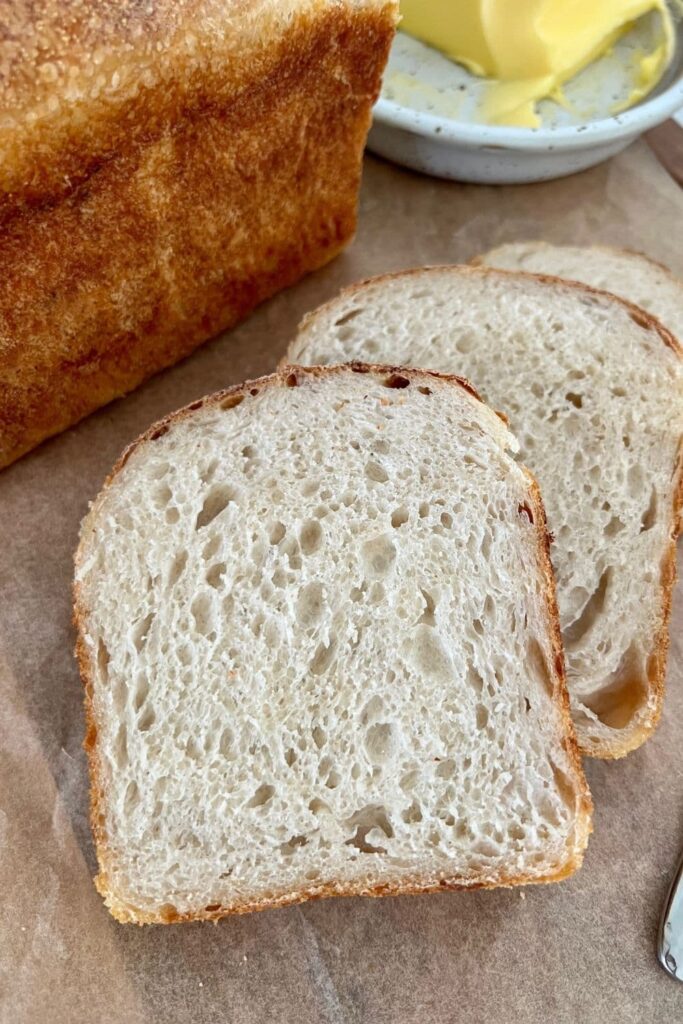
Benefits of Baking Sourdough In A Loaf Pan
The main benefits of baking sourdough in a loaf pan are:
- shaping technique isn't as important
- can bake at lower temperatures
- gives you a softer crust
- perfect shape for sandwiches and toast
- no need for heavy Dutch Oven
- better for over fermented dough as the loaf tin supports the dough
- easier to cut than a boule or batard
Let's look at the benefits of baking sourdough in a loaf pan in more detail.
Shaping Technique Isn't As Important
When baking sourdough bread, the shaping technique you use can affect the oven spring of the loaf and of course the overall look of the loaf once it's baked.
Using a loaf pan to bake sourdough bread means that the shaping technique becomes less important as the dough will take on the shape of the pan during proofing.
As you aren't removing it from the loaf pan to bake, the dough is also supported during baking, meaning it often rises higher and gives you better oven spring overall.
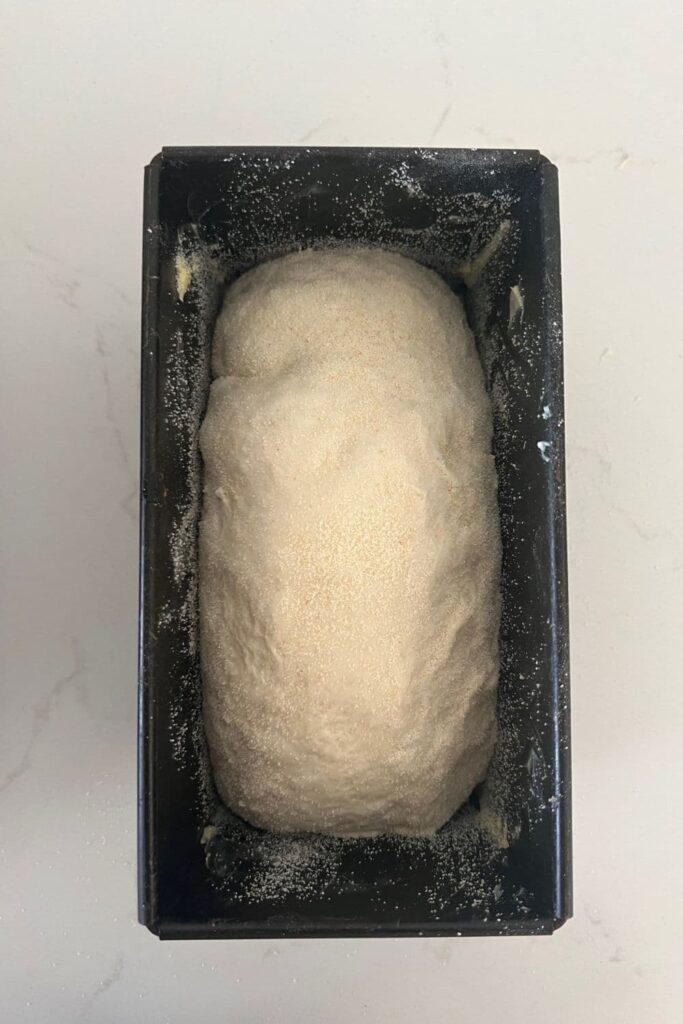
Bake Sourdough At Lower Temperatures
Using a loaf pan means that you can bake your sourdough at lower temperatures, since it is not having any time covered in a Dutch Oven or baking pot.
When baking traditional sourdough bread, you steam the loaf in a piping hot Dutch Oven, generally baking above 230C/446F. When using a loaf pan, the dough is uncovered for the whole bake so you need to lower the temperature to prevent the crust burning or becoming to hard and tough. I recommend 200C/392F for the whole bake, rather than a higher temp first and then dropping down.
Using a lower temperature can be a benefit, particularly if your oven doesn't reach super high temperatures or you're baking sourdough during the summer months.
Softer Crust Sourdough Sandwich Bread
Baking sourdough in a loaf pan will give you a softer outside crust, particularly around the sides and base of the loaf.
Before putting the sourdough bread dough into the loaf pan, you generally butter the pan. The butter helps to soften the loaf during baking time.
If you prefer a softer top crust, you can also brush this with butter when it comes out of the oven.
Perfect Shape for Sandwiches and Toast
One of the biggest benefits of baking sourdough in a loaf pan is that it makes it gives you a traditional loaf of sourdough bread ... just in the perfect shape to make a sandwich and fit your toaster!
If you love the flavor of sandwiches made from a batard or boule, you're going to absolutely love the convenient shape of sourdough bread made in a loaf tin - it makes life so much easier! No more trying to jam that big slice into your little toaster!
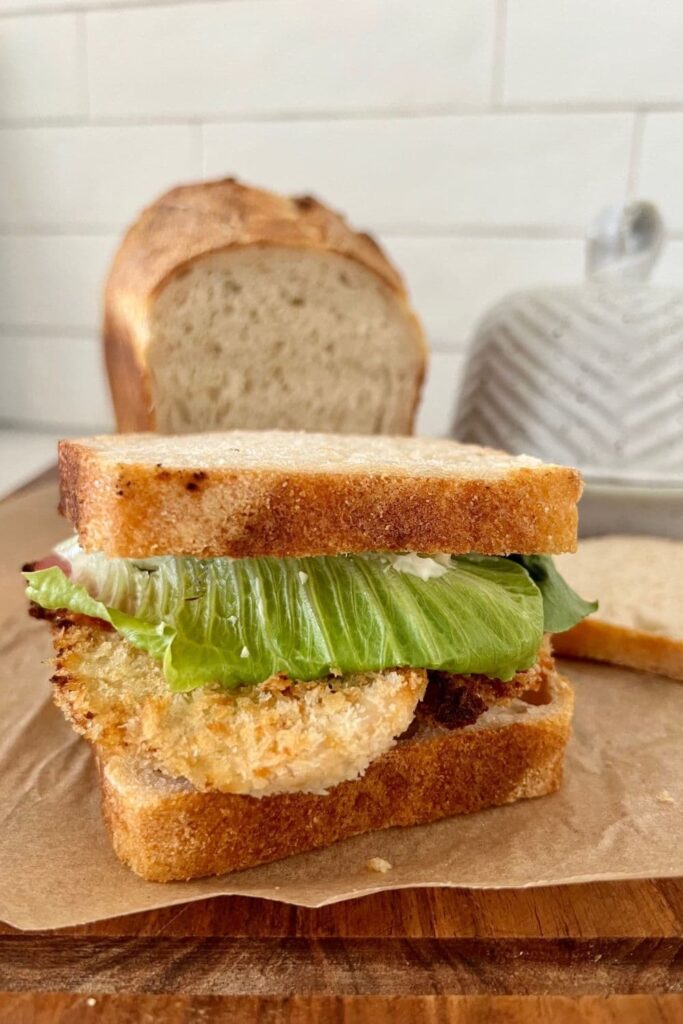
No Heavy Dutch Oven
If you have trouble lifting a Dutch Oven in and out of the oven, then using a loaf pan might be just the solution you're looking for. Of course, if you like the idea of covering you sandwich loaf, you could place a loaf tin of the same size on the top of your dough to trap the steam in. This is a popular method to emulate the conditions of a Dutch Oven, but without the weight.
Better for Over Fermented Dough
Using a loaf pan to shape your sourdough bread into a sandwich loaf can also help to support the dough - both during proofing and baking.
If your dough is a little over fermented, using a loaf pan can help to support the dough and allow it to bake up better than it would if you used a banneton and then tipped it out to bake it, where the dough would be unsupported.
A loaf pan can be a good alternative to a banneton for proofing if you want to experiment with allowing your dough to proof more than you normally would as you bake it in the tin, you're not tipping it out where it has to support itself.
Easier To Cut
If you've ever tried to cut through a crusty sourdough ear or an odd shaped loaf, you'll know that it can be quite a challenge - even with the best bread knife for sourdough bread!
Sourdough baked in a loaf tin can be much easier to cut because the crust is softer and the shape is easier to hold. A loaf pan sourdough also fits into a slicing guide much easier than a boule or batard.
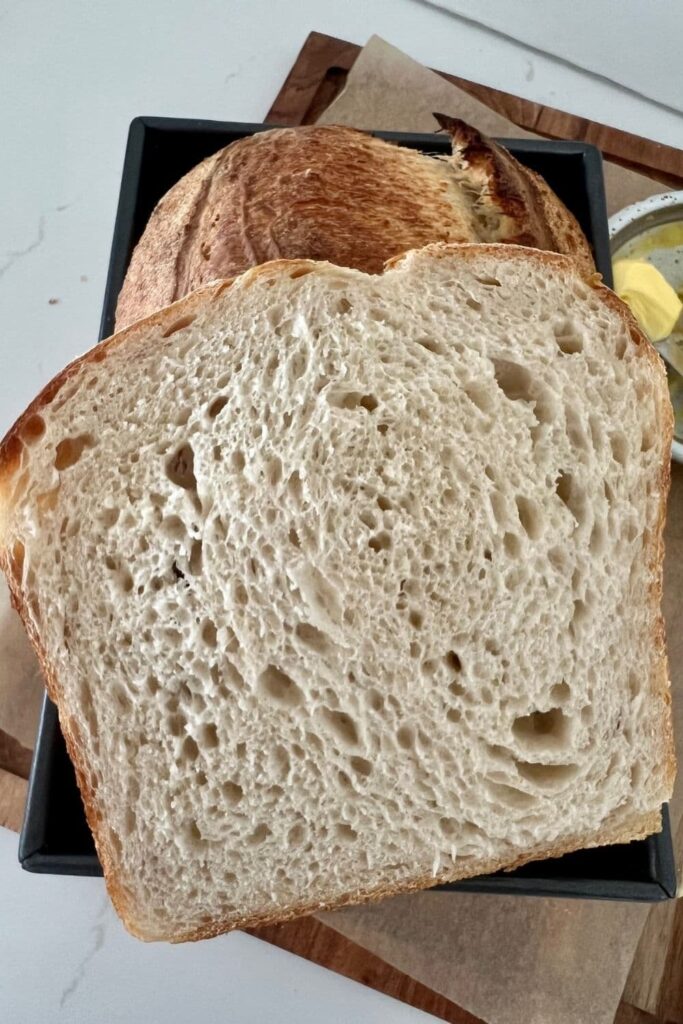
How to Bake Sourdough In A Loaf Pan (step by step guide)
Baking sourdough in a loaf pan follows the same basic steps as making my basic sourdough loaf. The main difference comes when it's time for shaping and proofing. The baking temperature for this sourdough recipe is also lower than what you may be used to.
The photographs featured in this section of the post are made using a double batch of dough (you can easily double the dough using the buttons in the recipe card). The dough is baked in a large farmhouse loaf pan (24cm x 16cm) - details of the pan are after the instructions.
Premix the Dough
Weigh out your sourdough starter and water into a large mixing bowl and mix together briefly.
Now add your flour and salt and mix whole lot together to form a dry, shaggy dough.
Cover your bowl with plastic wrap or a damp towel and let it sit for around 1 hour.
This process is called the "autolyse" and allows your flour to soak in all the water and become hydrated.
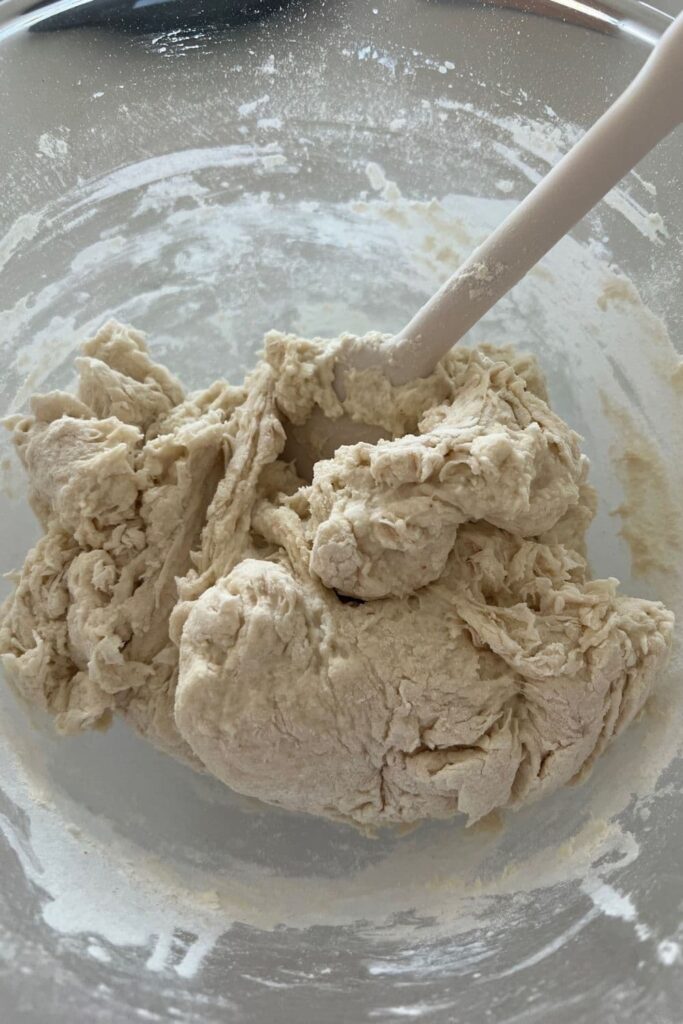
Forming Up The Dough
Bring the dough together into a ball. Pull the edges of the dough into the centre until it's smoother and more formed.
You'll notice that the dough is fully hydrated after soaking all the water up. It will be fairly sticky but as you bring it into a ball, it will become smoother and shinier.
Once the dough has formed into a smooth ball, pop the cling film back on and let it rest for 30 minutes.
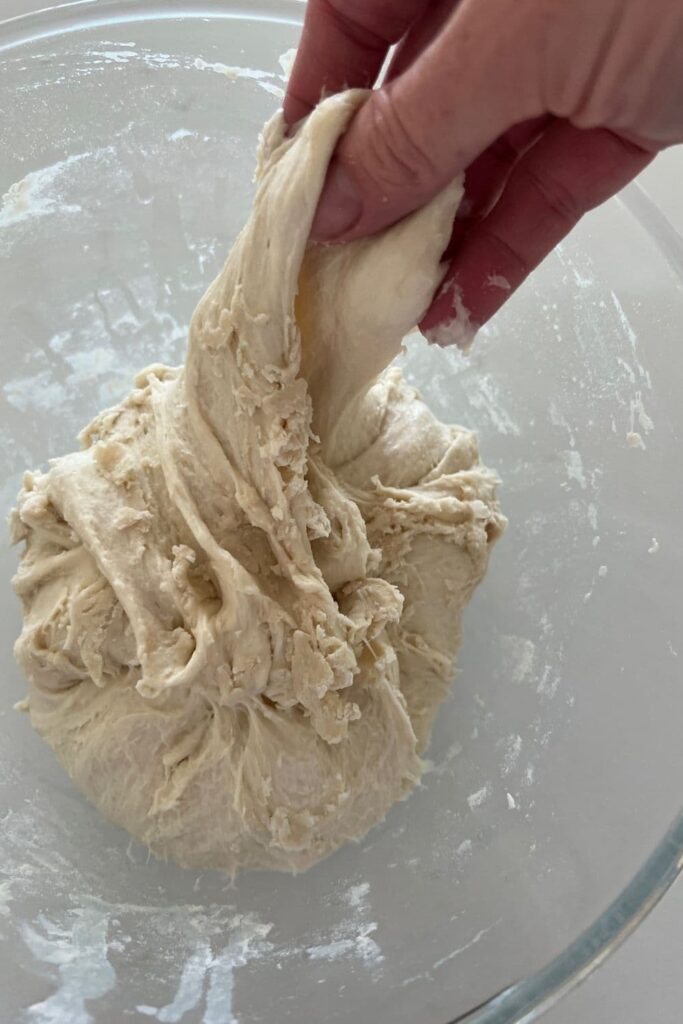
Stretches and Folds
Over the next few hours you need to create some structure for your dough by "stretching and folding".
Aim to do around 4-6 sets of stretches and folds.
For each set, stretch the dough up and over itself 4 times. Leave around 15 minutes in between each set. Again you do not have to be exact with time, but you need to do at least 4 sets over 2 hours.
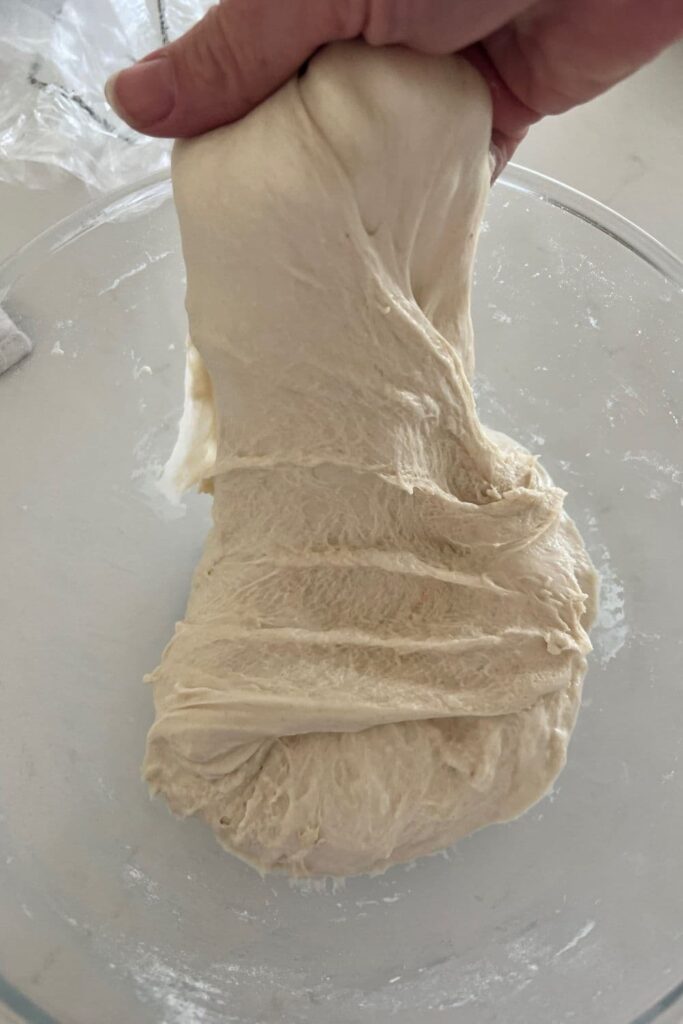
Bulk Fermentation
Once you've finished your stretch and folds, place the cling film or damp tea towel back over your dough and let it rest and ferment (a plastic cover is a better option for this stage). I let it rise to just under double for this recipe because you want it to rise a bit in the pan afterwards.
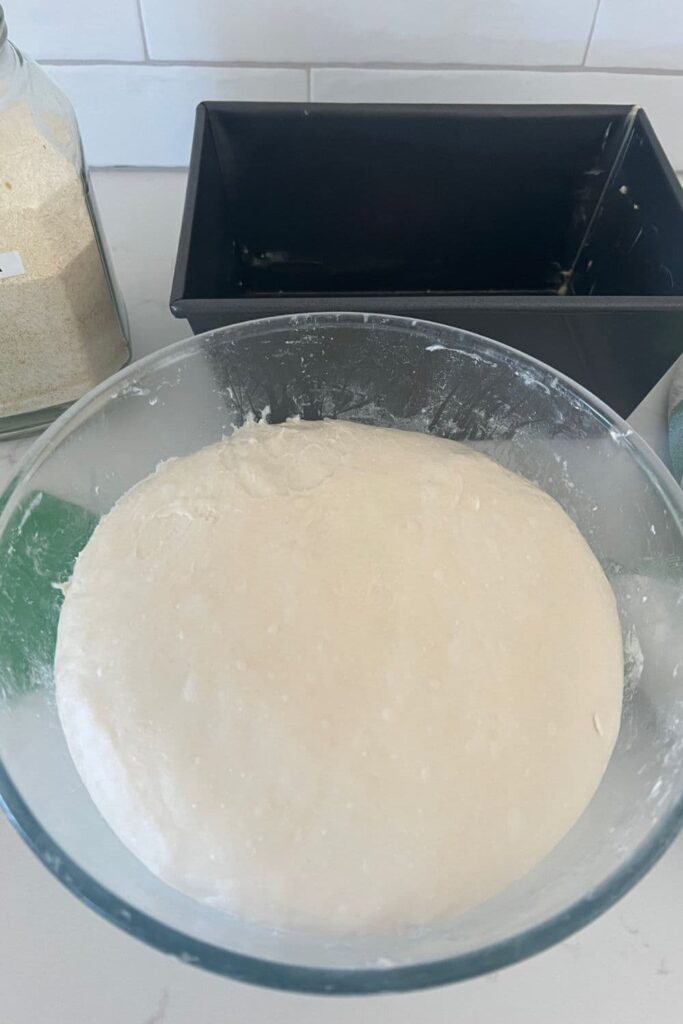
Shaping the Dough
Once your dough has finished it's first ferment, it's time to shape it so that it will fit into your loaf tin. Shaping your dough into a batard is the best for proofing and baking in a loaf tin.
You'll need to flour your counter top with rice flour for this (we use rice flour because it has no gluten). Try to be quite sparing with the rice flour, you only need a very light dusting. Semolina is also a good choice (and is what I have used in these photos).
Use a silicone dough scraper to gently ease the dough out of the bowl. You want it to land upside down on your counter so that the smooth top of the dough is on the countertop and the sticky underside is facing up. This will make it easier to shape.
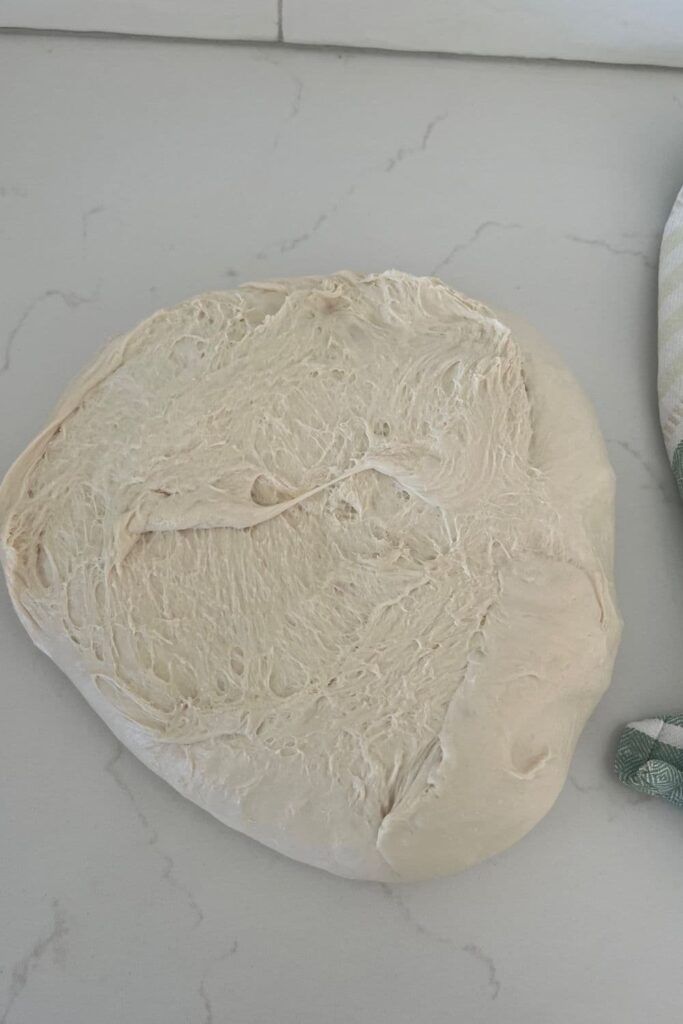
Shape the dough into a batard or loaf shape (you can see instructions for this here).
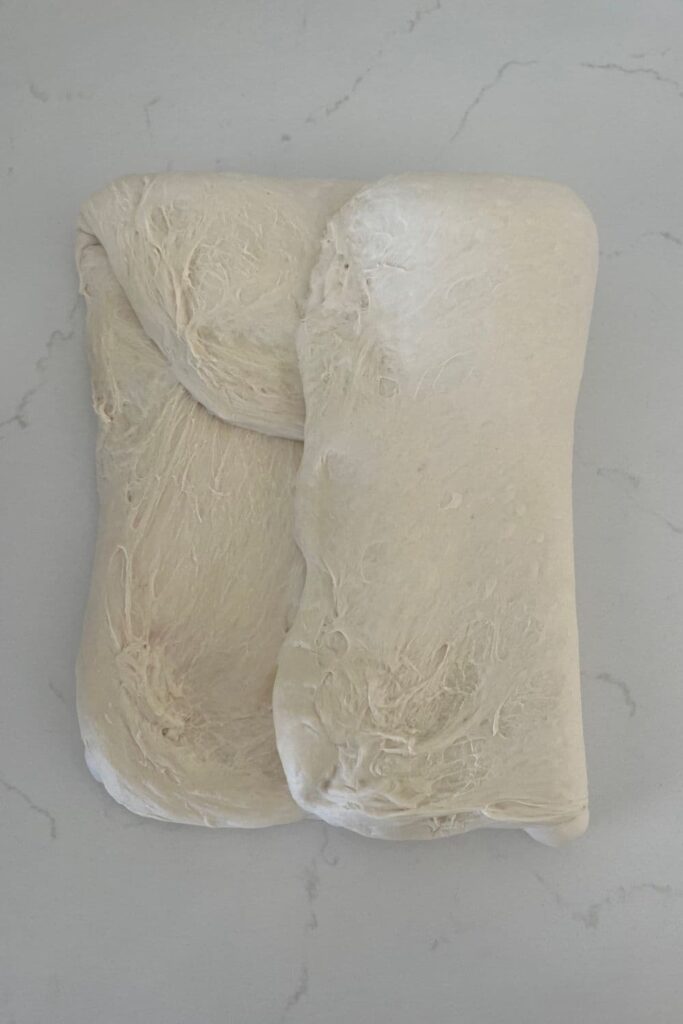
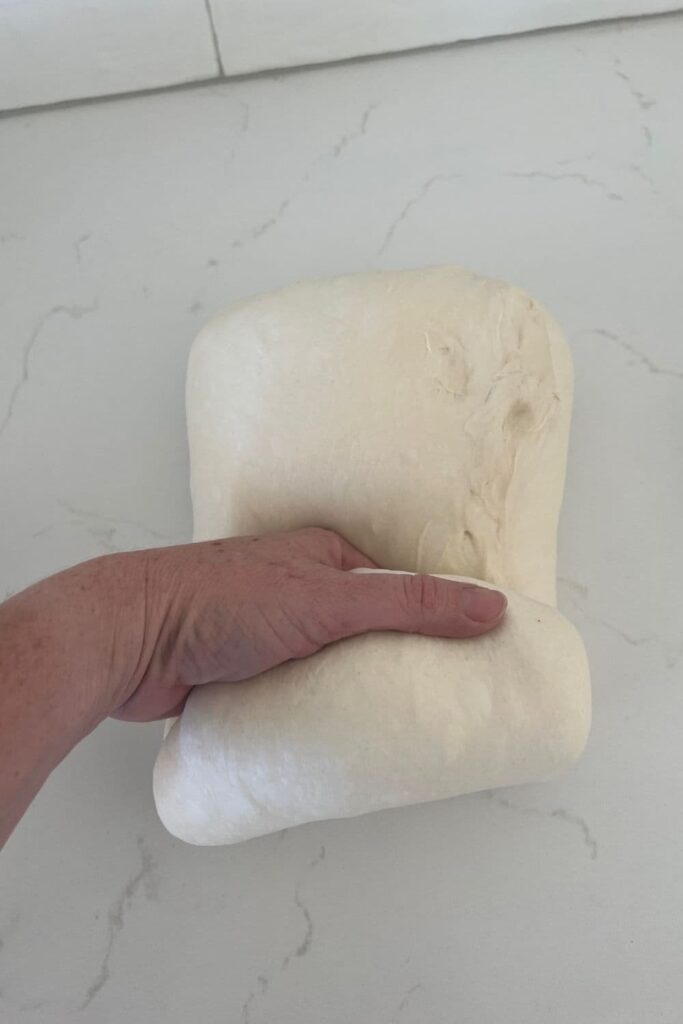
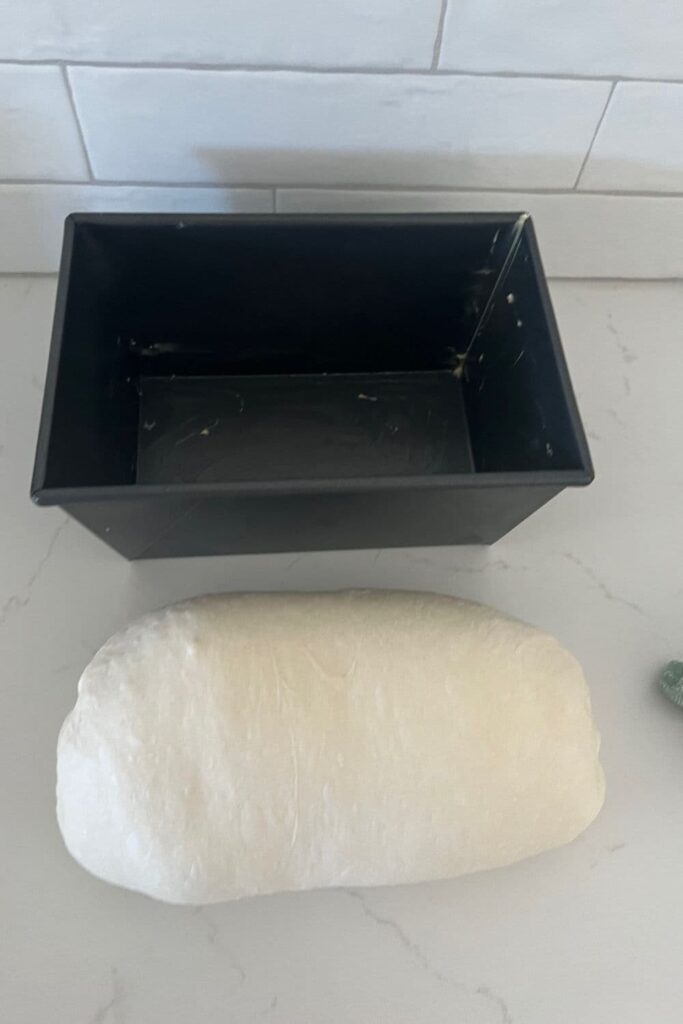
Putting The Sourdough Into the Loaf Pan
Lightly coat the inside of your loaf tin with butter. Dust it with semolina or rice flour.
Once the dough is shaped, you need to gently lift it into the loaf pan. You need to place it into the loaf tin with the seam on the bottom (opposite to how you would place it into a banneton).
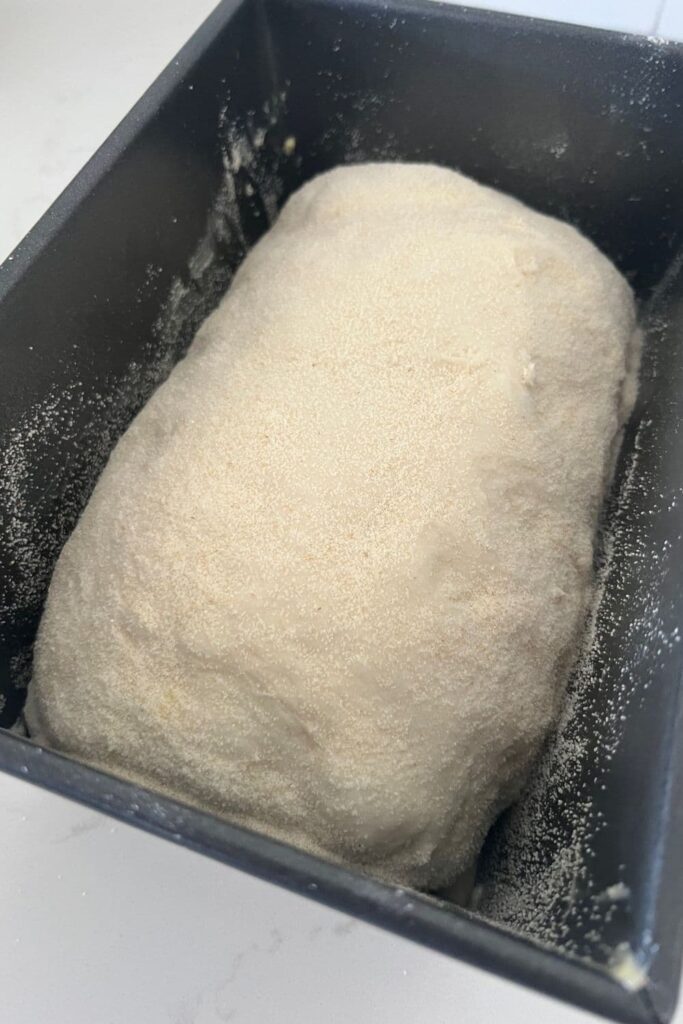
Proofing
Now the dough is in the loaf tin, you need to let it proof. For this sourdough loaf I like to proof it a little on the counter first and then put it in the fridge until I'm ready to bake.
As long as it didn't over ferment during bulk fermentation, allow the dough to puff up a bit before you put it in the fridge for cold fermentation. Don't let it go too far though or you won't have any oven spring.
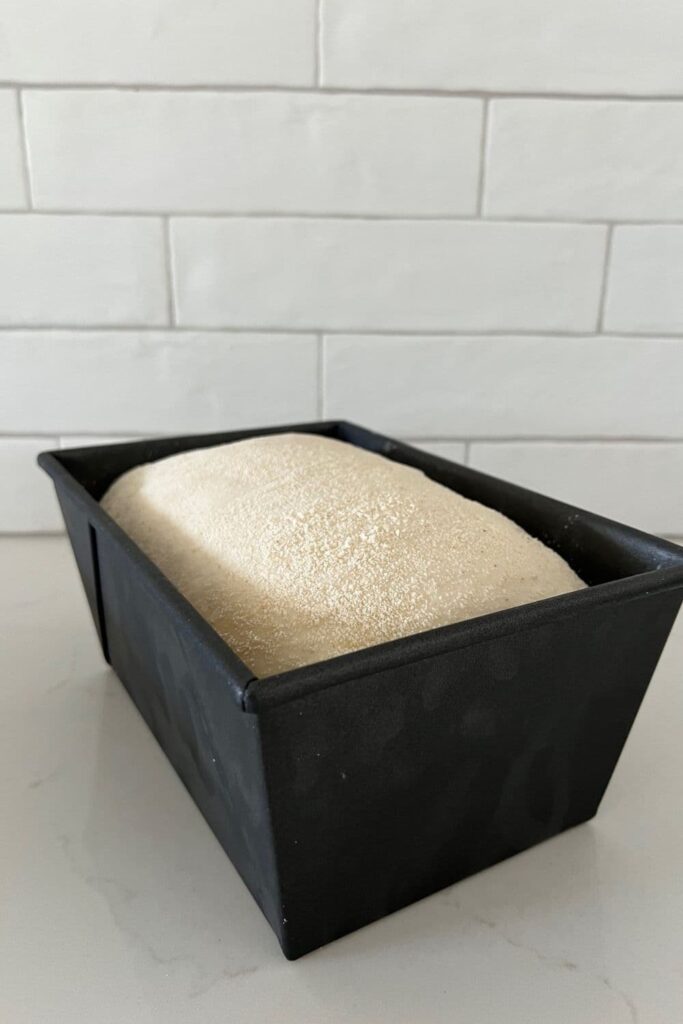
Preparing To Bake
Once you're ready to bake your sourdough, you'll need to preheat your oven to 200C/392F.
Bake Your Sourdough Bread In A Loaf Pan
Now it's time to bake!
When the oven is at temperature, take your loaf of sourdough out of the fridge and score it (you don't have to score it if you don't want to). Lightly spray the top of the dough with water. Place it into the hot oven.
BAKE TIME:
45 Minutes at 200C/392F
Let Your Bread Cool
When your sourdough is done, remove it from the oven. Let it sit for a few minutes and then carefully remove it from the tin. Place onto a wire rack to cool.
If you wish to soften the crust a little, you can brush the top of the loaf with melted butter if you wish.
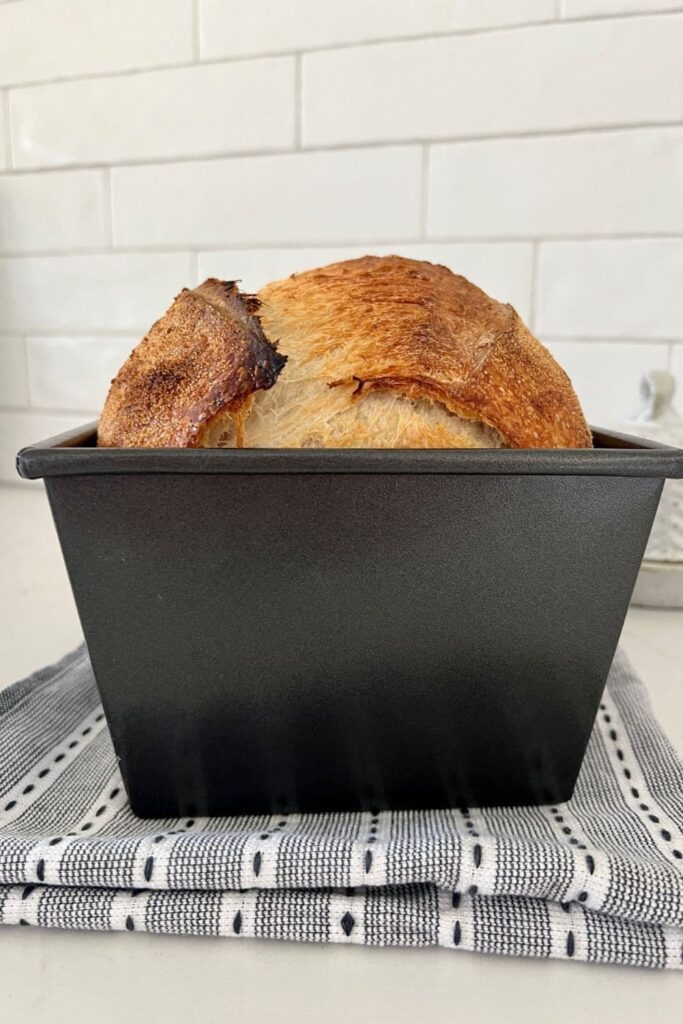
What Size Loaf Tin To Use for Sourdough Bread?
The large loaf photographed in this recipe is a double batch of dough baked in a Farmhouse Loaf Pan measuring 24cm x 16cm x 12cm or 9.5" x 6" x 4.7". This pan was purchased here, but you can find a similar size here and here.
For a single batch of dough I recommend a loaf pan measuring 22cm x 10cm x 11cm or 8.5" x 4" x 4.25" (this is the size of the pan used to make the loaf photographed below).
You can easily double or even triple the recipe for this loaf pan sourdough by using the buttons on the recipe card.
You can bake this simple sourdough recipe in either a metal or glass loaf pan. I prefer metal, however use whatever you have on hand.
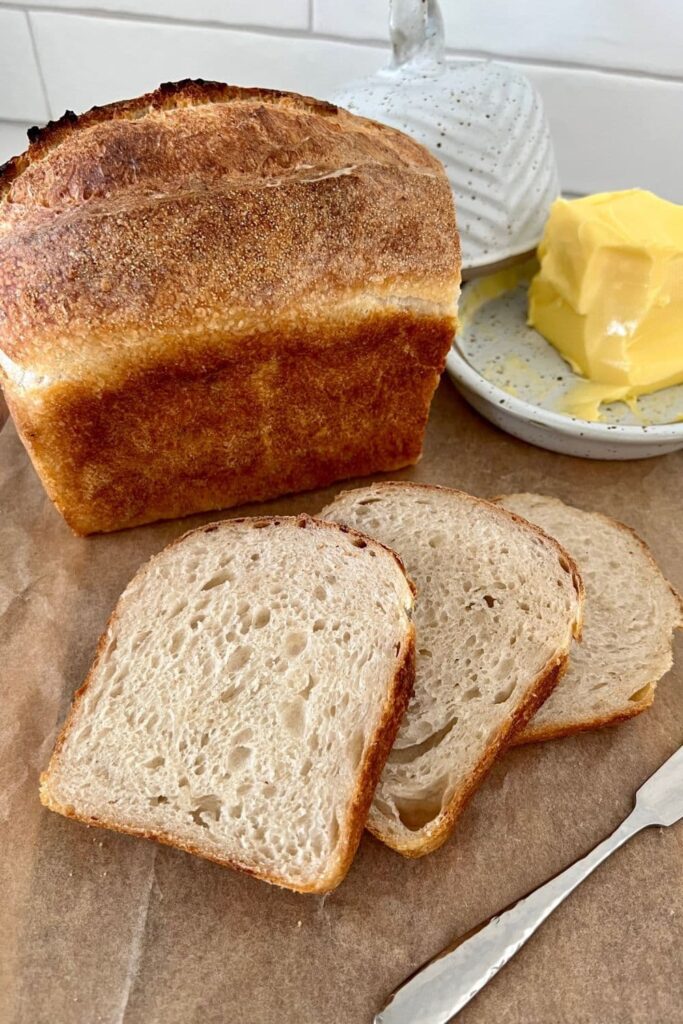
How Do You Adjust Baking Time for Sourdough In Loaf Pan?
It's fairly simple to adjust the timing for baking sourdough in a loaf pan. Unlike using a Dutch Oven to bake sourdough bread, using a loaf pan means that the loaf is uncovered for the entire time it is in the oven.
This means that you need to reduce the temperature to ensure that the top of the loaf doesn't burn. As a basic rule, I bake sourdough bread in a loaf pan for around 45 minutes at 200C/392F or until the crust is baked to my liking.
As you experiment more with baking sourdough in a loaf pan, you'll find a time that works for your perfect loaf.
Do You Score Sourdough Sandwich Bread?
If you are baking sourdough bread in a loaf pan, you can choose to bake it as a rounded loaf, with no score or you can score it so that it forms one or even two sourdough ears. The choice is really yours.
If you prefer a domed top to your loaves, you can leave it un scored and allow it to ballon up. The only problem with this is that if your loaf is under fermented, it may naturally tear open while it bakes.
I prefer to score the loaf down the centre and allow it to form an ear. This gives the sourdough in a loaf pan a more rustic look and feel.
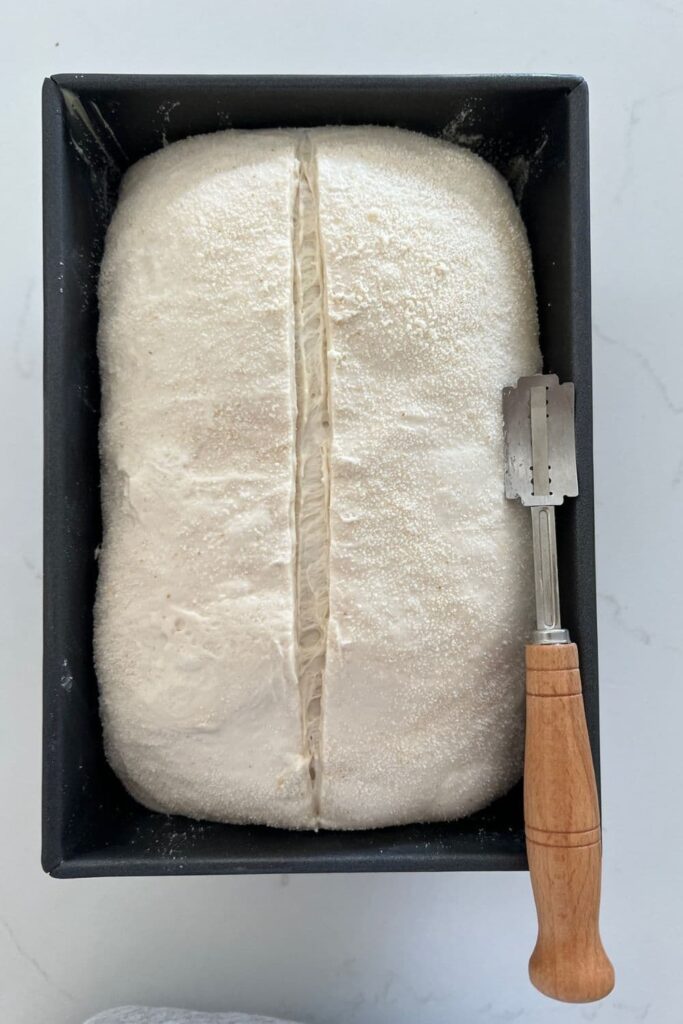
Frequently Asked Questions
No you don't need to cover your loaf pan sourdough bread, you can bake it uncovered in your oven at 200C/392F for 45 minutes. A spritz of water before you place it into the oven is a good idea and provides a little steam but it's not essential. You can place a loaf pan of the same size as you're using to hold your dough on the top to create a mini Dutch Oven, but it's definitely not essential.
If your sourdough bread tears at the sides of your sandwich loaf it generally indicates that your loaf is under fermented and or under proofed. Extend out the rise time and make sure that your dough is nice a puffy before you bake it.
Absolutely. Shaping your sourdough into 2 or 3 smaller balls and placing them side by side in a loaf pan makes a lovely shaped bread that can be torn or sliced into smaller loaves for freezing or sharing. Using this method of shaping with smaller balls of dough also makes the dough easier to handle than one big batch.
You could bake sourdough bread in a cake pan if you don't have a bread tin available. Cake loaf pans are generally smaller than bread pans so you will need to adjust your dough to suit this.
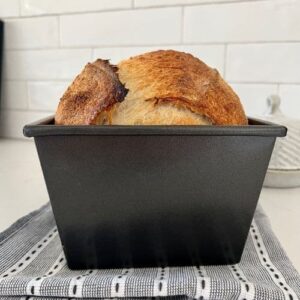
How To Bake Sourdough In A Loaf Pan
Equipment
- Mixing Bowl
- Digital Scales
- Loaf Tin (see notes below for size options)
Ingredients
- 500 g Bread Flour
- 350 g Water
- 100 g Sourdough Starter
- 10 g Salt
Instructions
PREMIX THE DOUGH
- Weigh out your sourdough starter and water into a large mixing bowl and mix together briefly.
- Now add your flour and salt and mix whole lot together to form a dry dough.
- Cover your bowl with cling film or a damp tea towel and let it sit for around 1 hour. This process is called the "autolyse" and allows your flour to soak in all the water and become hydrated. You can see how the dough has changed in this photo.
FORMING UP THE DOUGH
- Bring the dough together into a ball. Pull the edges of the dough into the centre until it's smoother and more formed.You'll notice that the dough is fully hydrated after soaking all the water up. It will be fairly sticky but as you bring it into a ball, it will become smoother and shinier.
- Once the dough has formed into a smooth ball, pop the cling film back on and let it rest for 30 minutes.
STRETCH & FOLD PHASE (STRENGTHENING PHASE)
- Over the next few hours you need to create some structure for your dough by "stretching and folding". Aim to do around 4-6 sets of stretches and folds. For each set, stretch the dough up and over itself 4 times. Leave around 15 minutes in between each set. Again you do not have to be exact with time, but you need to do at least 4 sets over 2 hours.
BULK FERMENTATION (RISE PHASE)
- Once you've finished your stretch and folds, place the cling film or damp tea towel back over your dough and let it rest and ferment (a plastic cover is a better option for this stage).
SHAPE THE DOUGH
- Once your dough has finished its first ferment, it's time to shape it so that it will fit into your loaf tin. Shaping your dough into a batard is the best for proofing and baking in a loaf tin.You'll need to flour your counter top with rice flour for this (we use rice flour because it has no gluten). Try to be quite sparing with the rice flour, you only need a very light dusting. Semolina is also ok for this.Use a silicone dough scraper to gently ease the dough out of the bowl. You want it to land upside down on your counter so that the smooth top of the dough is on the countertop and the sticky underside is facing up. This will make it easier to shape.Shape the dough into a batard or loaf shape (you can see instructions for this here).
PUT DOUGH INTO THE LOAF TIN
- Lightly coat the inside of your loaf tin with butter. Dust it with semolina or rice flour.Once the dough is shaped, you need to gently lift it into the loaf pan. You need to place it into the loaf tin with the seam on the bottom (opposite to how you would place it into a banneton).
PROOFING
- Now the dough is in the loaf tin, you need to let it proof. For this sourdough loaf I like to proof it a little on the counter first and then put it in the fridge until I'm ready to bake. As long as it didn't over ferment during bulk fermentation, allow the dough to puff up a bit before you put it in the fridge for cold fermentation. Don't let it go too far though or you won't have any oven spring.
PREPARE TO BAKE YOUR DOUGH
- Once you're ready to bake your sourdough, you'll need to preheat your oven to 200C/392F.
BAKE YOUR SOURDOUGH BREAD!
- Now it's time to bake!When the oven is at temperature, take your loaf of sourdough out of the fridge and score it (you don't have to score it if you don't want to). Lightly spray the top of the dough with water. Place it into the hot oven.BAKE TIME:45 Minutes at 200C/392F
LET YOUR BREAD COOL
- When your sourdough is done, remove it from the oven. Let it sit for a few minutes and then carefully remove it from the tin. Place onto a wire rack to cool.If you wish to soften the crust a little, you can brush the top of the loaf with melted butter if you wish.
Notes
- Notes on Flour: This recipe is written using strong Bread Flour. Bread flour has a higher protein content than All Purpose flour. If you choose to use All Purpose flour you may have a different result because of this. You can read more about the differences between All Purpose Flour and Bread Flour here.
- Notes on Sourdough Starter: This recipe is based on you having an active starter that you have fed a few hours before starting your bake. For info on how to make a sourdough starter, go here.
- Notes on Stretch & Folds: If you are going to do the stretch & folds on your bench top, spray your surface with water mist rather than using flour. You can leave the dough in the bowl if you want to. Wet your hands to stop the dough sticking - although it shouldn't be too sticky. It will get less sticky as you do your stretches and folds. For more information on how to do stretch and folds, go here.
- Notes on Bulk Fermentation: If your home is warm then your dough will ferment a lot faster and could be done in as little as a few hours. If it's colder, it will take longer. You will know your dough is ready to move to the next stage when it has *just* doubled in size. It will be fairly wobbly and full of bubbles. You should be able to see large air bubbles under the surface of the dough.
You don't want to let it go any further than doubled as it will be over fermented.
You'll find more information on these topics here:
When is my bulk ferment finished? What is the difference between cold ferment and bulk ferment? Why does the amount of starter matter?
- Notes on Loaf Pan: The large loaf photographed in this recipe is a double batch of dough baked in a Farmhouse Loaf Pan measuring 24cm x 16cm x 12cm or 9.5" x 6" x 4.7". This pan was purchased here, but you can find a similar size here and here. For a single batch of dough I recommend a loaf pan measuring 22cm x 10cm x 11cm or 8.5" x 4" x 4.25"

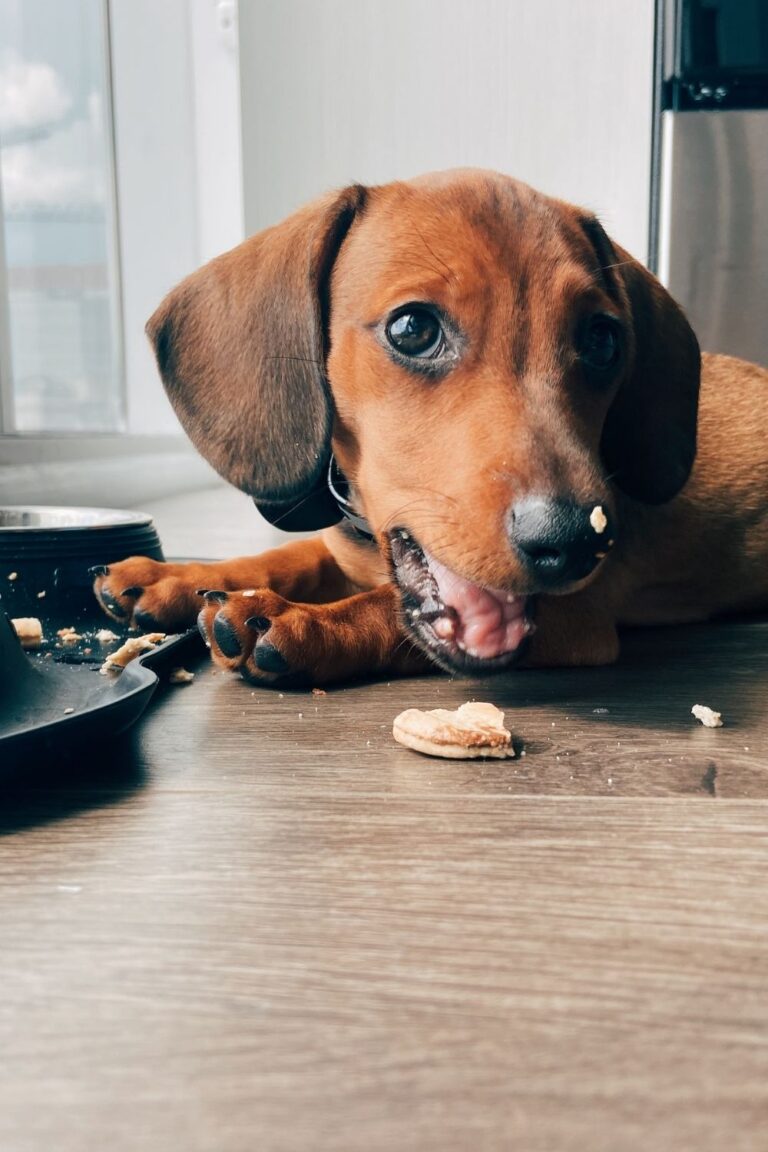
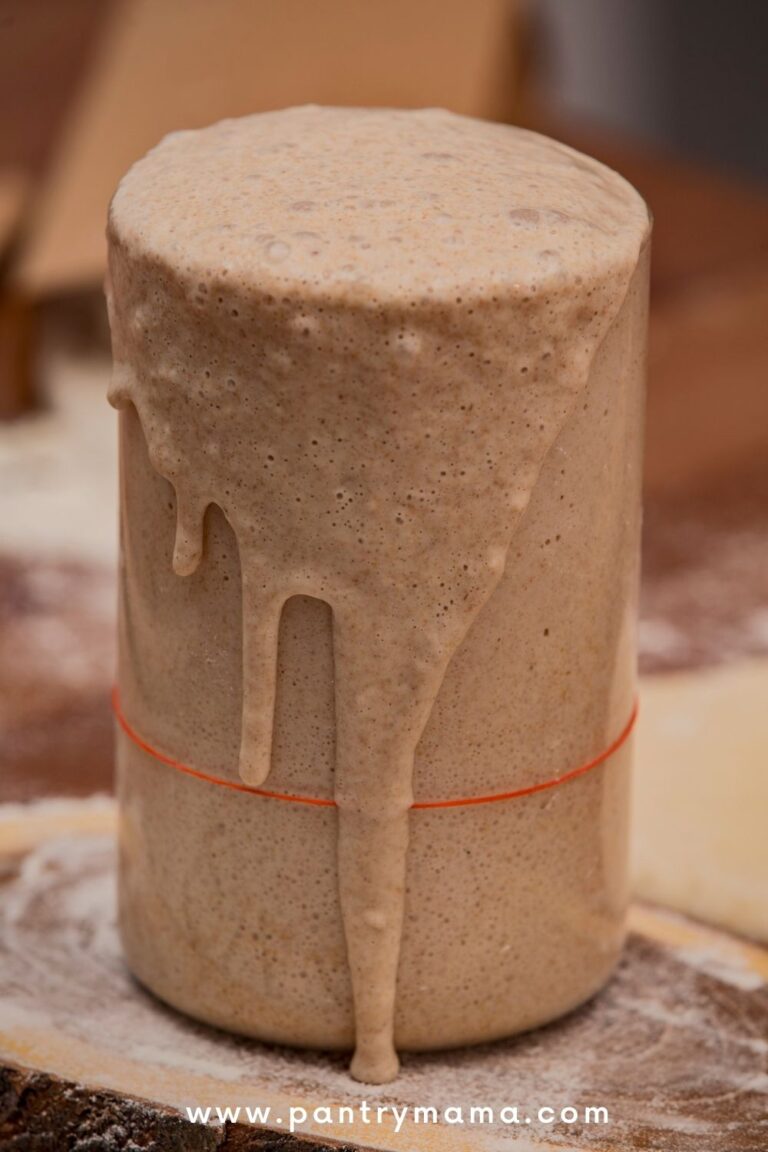
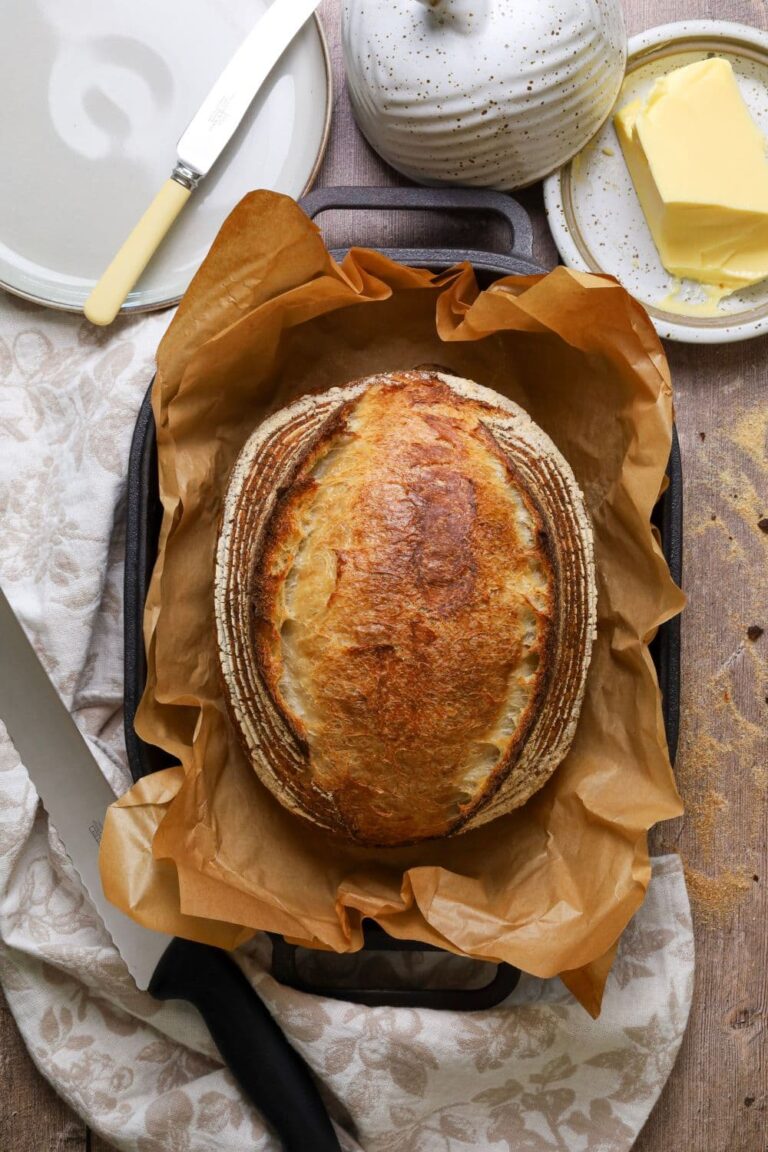
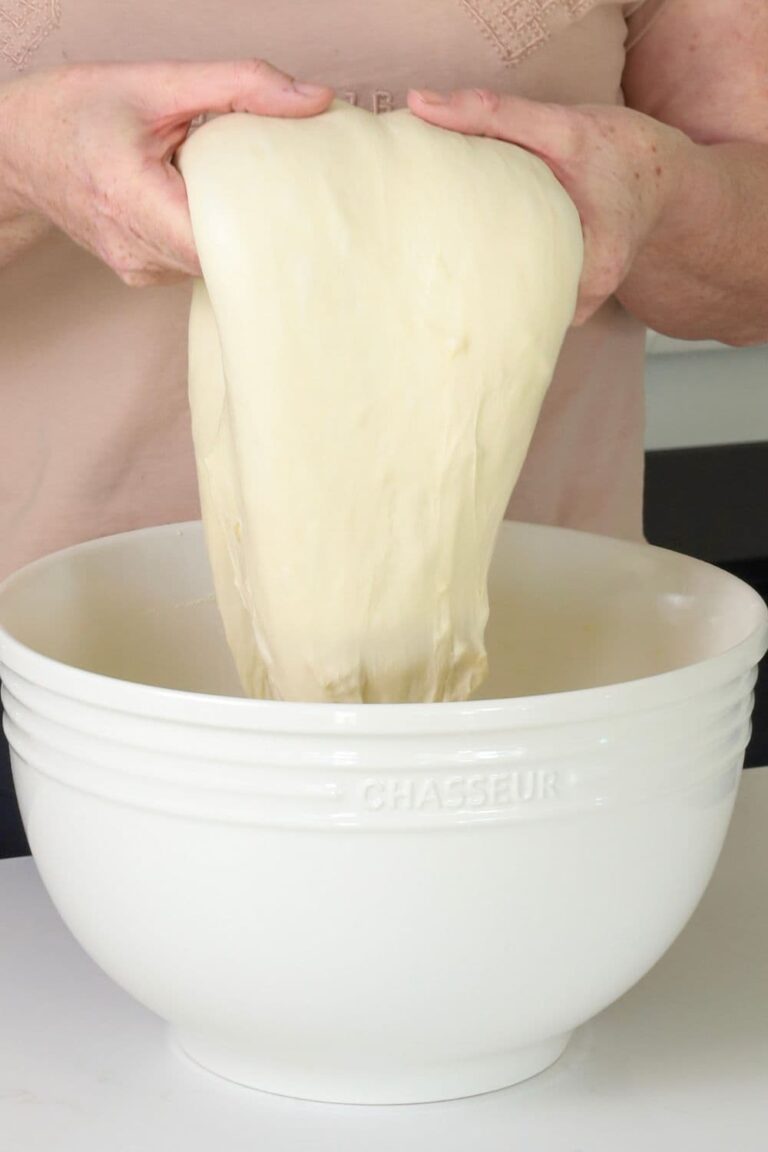

Help! No matter what I do my bread is only golden where it touched the pan and the top is a dull grayish light color. I’ve tried more water, less water, scoring and not scoring. I have been using convection but that’s what I always use with the Dutch over and it gets nice a golden after I take the lid off. I’ve slowly tried increasing the temps each loaf and nothing. The bread is great inside though. Should I increase temp or time or avoid convection?
I would say this is more of a fermentation issue. Dough that is under fermented will not brown up at all.
Do you bake it straight from the fridge, or let it cool to room temperature first? Thanks!
Let it come to room temperature first.
I've been doubling this recipe. I had one loaf stay in perfect shape and the other almost had a top side blowout. It is distended but didn't blow out. Is this due to shaping.
This can be caused by shaping as well as under fermentation 🙂
I love the recipe! Can I use this same recipe and shape and bake it in a Dutch oven? I’ve only made this recipe so I’m s a little unsure how to do that.
I'm so glad you love this recipe. You absolutely can bake it in a Dutch oven if you prefer x
I want to use a cast iron loaf pan (with flat cast iron lid) to bake sourdough bread. What are the recommended steps for doing this?
Regarding the loaf pan: I have several types from cheap to expensive. Can a glass loaf pan be used? Will it effect the outcome of the bread?
You can use glass if you want to. I'm not a fan to be honest, but if you like using glass, and your pan can handle the heat of the oven, then you can certainly use it.
I followed this recipe to a T but my loaf came out golden brown on the sides and a weird matte pale colour on the top! It looks unappealing lol! Help!
It's possible you didn't give enough time to proof. How did the inside look?
I make this over and over! So easy, so good. Can I sub for fresh milled whole grain?
I'm so glad you love the recipe! I haven't tried this one with freshly milled whole grain, but you could use this sourdough whole wheat sandwich loaf and bake it in a loaf pan 🙂 x
Do I need to cover at all during the baking process, so it doesn’t burn on top?
You don't have to, but you can use another loaf pan on the top of the bottom pan to cover the loaf while it bakes if you want to 🙂
Success! My best loaf so far. This is going to be my go to recipe. You have the best sourdough baking website. It's packed with valuable info and lots of pictures to help along the way. Sending you a big 'ol hug from Oklahoma!
We love to hear that, Gwen! 🙂
Excellent recipe. Thanks for sharing this. BTW, to be technically accurate (I can't help myself), an 'Autolyse' does not include any starter, or salt, etc. It's simply the flour and water, mixed together and allowed to rest (~1 hr) before adding the remaining ingredients.
If you include starter, salt, etc., it's referred to as a 'Fermentolyse' during that initial 1 hour rest period. Cheers
I baked loaf #1 this morning. I made a double recipe since I don’t bake that often. It turned out really good! I baked at 390 degrees for 45 minutes and it tempt at 107.9. I’ll bake the other loaf a little later. It’s still proofing in the fridge. AND the finished loaf is delicious!
Do you just bake it without steaming it? This is my first time making sourdough and I want to do it right. Other videos/recipes have it steaming in the oven.
You don't have to steam it, you can open bake it in a loaf pan 🙂
Made my first loaf sourdough bread today and it’s delicious!!! Loved the recipe! Question: the top of the loaf is somewhat tough…I sprayed it with water before baking, not sure if that’s the reason? The bottom is soft, top not so much! Thoughts? Thanks!!!
A quick fix for this is to rub the top of the loaf with butter when you first take it out of the oven 🙂
If I am covering loaf pan with another pan then what temp and time please?
If you're covering the loaf with another pan, you could do 30 minutes pan on at 230C(450F) and 10 minutes pan off at 210C (410F).
This is my go to for long ferment sourdough. I use the discard sandwich bread for getting rid of discard.
This recipe is amazing. It made the best bread. I baked it in a loaf tin with lid for first 20 mins and then took lid off and baked for another 25 mins.
This is a no fail recipe!! I've used it exclusively for all my bread!!!!
I'm so happy for you! Love that's it's your go to recipe 🙂 x
I love this recipe! I am now ready to try the doubled recipe for a bigger loaf, I just have one question , do I bake it the same amount of time? Thank you so so much for all that you share here! It has helped me on my sourdough journey and I am just loving it.😊
I'm so glad you love this recipe! If you double the recipe, you'd definitely need to increase the bake time. I would probably add an extra 20 minutes to start with and see how you go from there 🙂
Thank you so much for all the insight and your content is extremely creative! I am trying the loaf after a dozen traditional round loaves.
Question:
I have a cast iron loaf pan, is it ok to let it proof in there and then put into the fridge for cold fermentation? Do I need to to do anything different (cook times, warm up) before going into the over? Thank you in advance!
I'm so glad you're loving the creativity and insights 🙂 When I use a cast iron loaf pan to bake my bread, I actually cold proof in a banneton as per normal and then pre heat the cast iron loaf pans and then place the loaves in them once they're preheated. I've never actually cold proofed in my cast iron loaf pans.
Excellent recipe!
Much to my amazement it came out perfectly on my very first attempt, using my own starter!!
Can someone clarify the actual nutritional info please? The numbers provided cannot possibly correlate to 'per 100g' as stated surely??
So glad it worked for you 🙂 The nutritional info is per loaf, so you'll need to divide it by your number of slices to get accurate info 🙂
Can you give me a timeline on this sourdough loaf?
You'll find a timeline listed in my simple sourdough loaf recipe, as well as in my Sunday Sourdough post 🙂 I hope this helps x
I’ve been really enjoying making this recipe. It’s my go to!
Can I add inclusions to this, and if so, when?
Absolutely you can add inclusions. It's generally best during the stretches and folds.
I made a mistake and put into pans before proofing. Should I just leave them in the pan until proofed then take them out and reshape into loaves?
Yes, generally you would bulk ferment, then shape and put into loaf pans to proof. Just see how they proof up, the loaf pan should take care of the shape, so as long as they are nice and puffy, I would just leave them 🙂